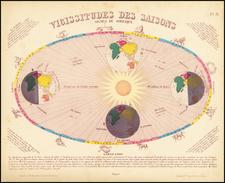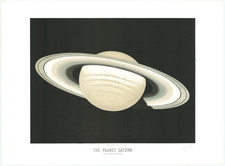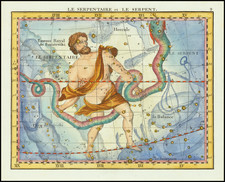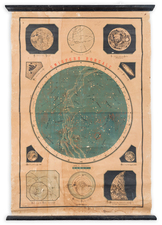A Magnificent Depiction of a Solar Prominence. Made by the "Audubon of the Sky", Etienne Trouvelot.
This is a beautiful color lithograph showing ejections from the outermost layer of the sun, made by Etienne Trouvelot and relating his observations made in the spring of 1873. The chromolithograph was published as part of Trouvelot's Astronomical Drawings set of 15 plates by Charles Scribner's Sons in 1882.
Trouvelot's drawings are known as some of the best images of the sky ever made. Trouvelot's work was very important at the time, as it provided important images of the stars, planets, and phenomena of the sky at a time when popular interest in astronomy was growing, but photography had not yet become advanced enough to capture such dark images. Trouvelot's images are recognized as the last of the great images of the night sky that surpassed the photography of their day.
"Flame-Like Tongues of Live Embers"
Solar prominences are vast structures, hundreds of thousands of miles in length, which are often loop-shaped. These extensions of cooler plasma are still mysterious, and while their properties are somewhat understood, why they form is not. They exist for weeks to months and can produce coronal mass ejections.
Records of observed solar protuberances exist from at least the 12th century, if not earlier. These are most obviously visible during eclipses, and by the 18th century they were studied regularly. The first hypothesis as to their existence was that they were clouds in the lunar atmosphere. Trouvelot apparently did not base his work solely off of an eclipse, with his date of May 5th, 1873 not corresponding to an ecliptical date, though he did make some relevant observations during the May 5th, 1878 lunar eclipse.
Trouvelot provides a useful description of the phenomena shown as follows in his Trouvelot Astronomical Drawings Manual:
A view of an upheaval of the chromosphere, or third outlying envelope of the sun, as observed with the…telescope with spectroscope attached.
The black background represents the general darkness of the eye-piece to the spectroscope. The broad red stripe stretching from top to bottom of the Plate is a portion of the red band of the spectrum, magnified about 100 times as compared with the actual spectroscopic view. The upper and lower edges of the cross-section of dusky red correspond with the edges of the slit, opened widely enough to admit a view of the chromospheric crest and of the whole height of the protuberance at once. With a narrower opening of the slit this background would have been nearly black, its reddish cast increasing with the amount of opening and consequent admission of diffused sun-light. Rising above the lower edge of the opening is seen a small outer segment of the chromosphere, which, as a portion of the sun’s eastern limb, should be imagined as moving directly towards the beholder. The seams and rifts by which its surface is broken, as well as the distorted forms of the huge protuberances show the chromosphere to be in violent agitation. Some of the most characteristic shapes of the eruptive protuberances are presented, as also cloud-like forms overtopping the rest. In the immediate foreground the bases of two towering columns appear deeply depressed below the general horizon of the segment observed, showing an extraordinary velocity of motion of the whole uplifted mass toward the observer. The highest of these protuberances was 126,000 miles in height at the moment of observation. The triple protuberance at the left with two drooping wings and a tall swaying spire tipped with a very bright flame, shows by its more brilliant color the higher temperature (and possibly compression) to which its gases have been subjected. The irregular black bands behind this protuberance indicate the presence there of less condensed and cooler clouds of the same gases. The dimmer jets of flame rising from the chromosphere are either vanishing protuberances, or, as in the case of the smallest jet shown at the extreme right of the horizon, are the tops of protuberances just coming into view.
Rarity
Trouvelot's prints were originally intended for the astronomical and scientific community and most of the larger US observatories purchased copies of the portfolio. In 2002, B.G. Corbin undertook a census to determine the number of surviving copies of the complete set of 15 prints and was only able to confirm the existence of 4 complete sets.
Trouvelot (1827-1895) was born in Guyencourt, Aisne, France. During his early years he was apparently involved in politics and had Republican leanings. Following a coup d'état by Louis Napoleon in 1852, he fled or was exiled with his family to the United States, arriving in 1855. They settled in the town of Medford, Massachusetts, where he worked as an artist and nature illustrator. In both 1860 and '70 census, his occupation is listed as lithographer.
Trouvelot had an interest as an amateur entomologist. In the U.S., silk-producing moths were being killed off by various diseases. Trouvelot brought some Gypsy Moth egg masses from Europe in late 1866 and was raising gypsy moth larvae in the forest behind his house. Trouvelot apparently understood the danger posed by the Gypsy Moths and housed them under netting. Unfortunately, an egg mass went missing during a storm in 1869. He immediately realized the potential problem he had caused and notified some nearby entomologists, but nothing was done. This story has been called into question, based on earlier reports Trouvelot made that his netting had holes in it large enough for robins to fit through and eat his caterpillars.
Shortly following this incident, Trouvelot lost interest in entomology and turned to astronomy. In this field he could put his skills as an artist to good use by illustrating his observations. His interest in astronomy was apparently aroused in 1870 when he witnessed several auroras.
When Joseph Winlock, the director of Harvard College Observatory, saw the quality of his illustrations, he invited Trouvelot onto their staff in 1872. In 1875, he was invited to the U.S. Naval Observatory to use the 26-inch refractor for a year. During the course of his life he produced about 7,000 quality astronomical illustrations. 15 of his most superb pastel illustrations were published by Charles Scribner's Sons in 1881. He was particularly interested in the Sun, and discovered "veiled spots" in 1875. Besides his illustrations, he published about 50 scientific papers.
In 1878, Trouvelot and his son traveled to Creston, Wyoming Territory, to observe the total eclipse of the Sun on July 29.
By 1882, Trouvelot had returned to France and joined the Meudon Observatory. He worked there under Jules Janssen, a leading solar astronomer. However, Trouvelot resented the cloudy French sky, which impeded his observations. He traveled with Janssen to the Caroline Islands in the South Pacific to observe the total eclipse of 1883 and attempt to discover the phantom intra-Mercurial planet.
Trouvelot died at Meudon on April 22, 1895. At the time he was working on a monograph of Mars. His son, George, hoped to find a publisher for Etienne's drawings of Mars, but was unsuccessful. The whereabouts of almost all of the drawings left by Trouvelot to his family are currently unknown.










![[Ion Powered Spacecraft Traveling To Mars]](https://storage.googleapis.com/raremaps/img/small/83629.jpg)
![[ Equuleus ]](https://storage.googleapis.com/raremaps/img/small/83195.jpg)


